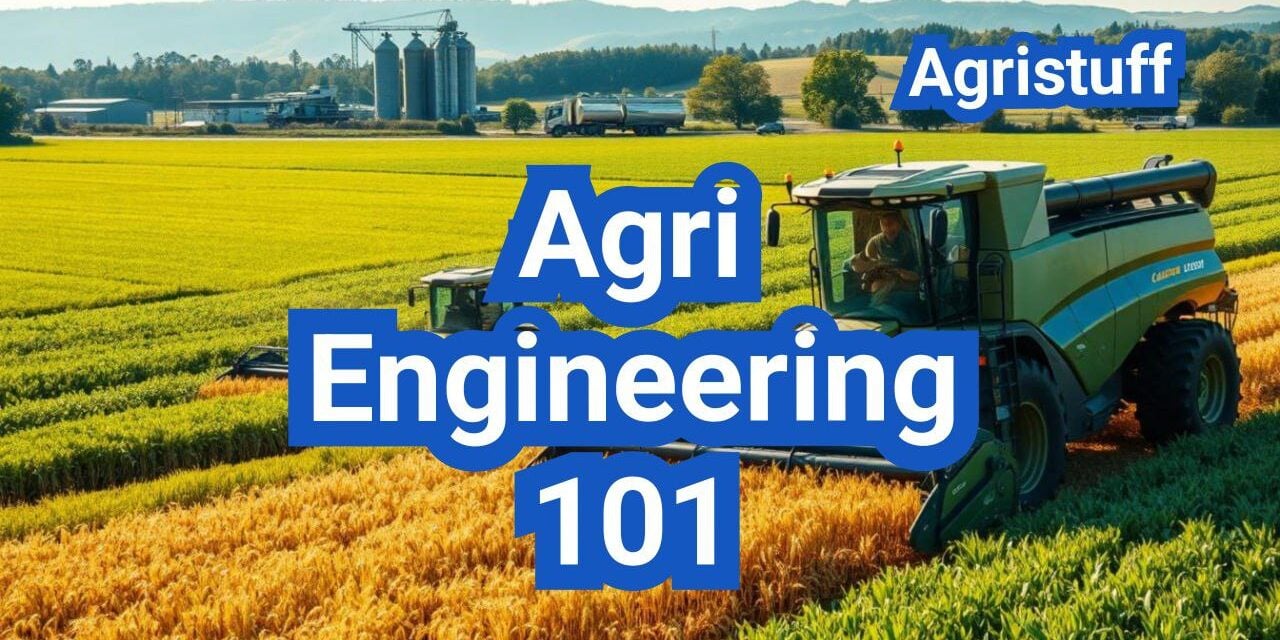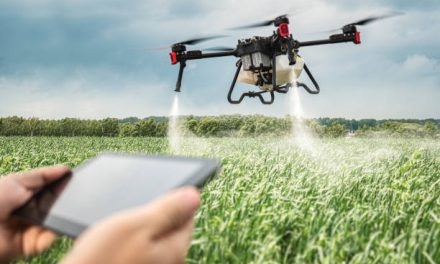Agricultural engineering plays a crucial role in modern agriculture by applying engineering principles to agricultural production and processing.
Designing and developing machinery, structures, and equipment for farming are key aspects of this field, contributing to improved productivity and sustainability in farming practices.
The importance of agricultural engineering lies in its ability to innovate and enhance farming operations, making them more efficient and environmentally friendly.
Key Takeaways
- Agricultural engineering is vital for modern agriculture.
- It involves designing machinery, structures, and equipment for farming.
- Improved productivity and sustainability are key benefits.
- Innovation in farming operations is driven by agricultural engineering.
- Efficient and environmentally friendly farming practices are promoted.
The Evolution of Agricultural Engineering in America
From manual labor to mechanization, the evolution of agricultural engineering has revolutionized American farming practices. The early 20th century marked the beginning of significant transformations in agricultural engineering, driven by the need for increased efficiency and productivity.
From Manual Labor to Mechanization
The transition from manual labor to mechanized farming was a pivotal moment in the history of agricultural engineering. The introduction of tractors and other machinery reduced the physical burden on farmers and significantly increased the scale of farming operations. This mechanization was accompanied by the development of new farming techniques and tools, further enhancing productivity.
Key innovations included the introduction of the first gasoline-powered tractors and the development of irrigation systems. These advancements allowed farmers to cultivate and manage larger areas more effectively, contributing to the growth of the agricultural sector.
Modern Challenges Driving Innovation
Today, agricultural engineering continues to evolve in response to modern challenges such as sustainability, food security, and environmental protection. The increasing global demand for food, coupled with the need to reduce environmental impact, has driven innovation in agricultural engineering.
Modern agricultural engineers are developing precision agriculture technologies, including GPS-guided equipment and drone-based monitoring systems. These technologies enable farmers to optimize crop yields, reduce waste, and minimize environmental impact.
The integration of technology and engineering principles is crucial for addressing the complex challenges facing modern agriculture. As the field continues to evolve, agricultural engineers will play a vital role in shaping the future of farming in America.
What Is Ag Engineering and Why It Matters

At its core, agricultural engineering is about applying technical knowledge to improve farming and food production processes. This discipline combines engineering principles with agricultural practices to develop innovative solutions for the challenges faced by the agricultural sector.
Defining the Discipline
Agricultural engineering is defined as the application of engineering principles to agricultural production and processing. It encompasses a broad range of topics, including machinery design, irrigation systems, and farm structures. Agricultural engineers work to improve the efficiency and productivity of farming practices, ensuring that food production meets the demands of a growing global population.
Economic Impact on U.S. Agriculture
The economic impact of agricultural engineering on U.S. agriculture is significant. By developing and implementing more efficient farming practices and technologies, agricultural engineers contribute to the sector’s productivity and competitiveness. This not only benefits farmers through increased yields and reduced costs but also has a positive effect on the broader economy. According to the U.S. Department of Agriculture, advancements in agricultural technology have led to substantial economic benefits, including increased crop yields and improved resource allocation.
Sustainability Through Engineering Solutions
Agricultural engineering plays a crucial role in promoting sustainability in agriculture. Through the development of innovative engineering solutions, agricultural engineers help reduce the environmental impact of farming practices. This includes designing more efficient irrigation systems, developing machinery that reduces soil compaction, and implementing practices that minimize waste and pollution. By enhancing the sustainability of agricultural practices, agricultural engineers contribute to a more environmentally friendly food production system.
The integration of engineering principles into agriculture is vital for addressing the challenges faced by the sector, including climate change, resource scarcity, and food security. As the global population continues to grow, the role of agricultural engineering in ensuring sustainable and productive farming practices will become increasingly important.
Pursuing a Career in Agricultural Engineering
Pursuing a career in agricultural engineering involves acquiring a strong educational foundation in engineering and agricultural sciences. This field combines principles from engineering, biology, and agricultural sciences to develop innovative solutions for agricultural practices.
Degree Programs and Specializations
Agricultural engineering degree programs are designed to provide a comprehensive education that includes coursework in engineering mechanics, biology, and agricultural sciences. Students can choose from various specializations such as:
- Irrigation and drainage engineering
- Agricultural machinery design
- Farm structures and environmental control
- Soil and water conservation
These specializations equip students with the knowledge and skills required to address specific challenges in agricultural engineering.
Essential Skills and Knowledge Requirements
To succeed in agricultural engineering, professionals need a strong foundation in:
- Engineering principles and mathematics
- Agricultural sciences and biology
- Problem-solving and analytical skills
- Communication and project management skills
Agricultural engineers must stay updated with the latest technologies and innovations in the field to effectively design and implement solutions.
Career Opportunities in the Agricultural Sector
Agricultural engineers can explore various career paths, including:
| Career Path | Description |
|---|---|
| Research and Development | Designing and testing new agricultural equipment and technologies |
| Industry | Working with manufacturers and suppliers of agricultural equipment and supplies |
| Government Agencies | Developing and implementing policies and programs related to agricultural engineering |
The demand for agricultural engineers is driven by the need for sustainable agricultural practices, technological advancements, and environmental conservation.
Designing Efficient Farm Structures

The design of farm structures plays a crucial role in the productivity and sustainability of agricultural operations. Agricultural engineers must consider various factors when designing these structures to ensure they meet the needs of farmers while promoting animal welfare and productivity.
Planning Post-Frame Barns for Maximum Utility
Post-frame barns are a popular choice for farm structures due to their durability and versatility. When planning these barns, it’s essential to consider factors such as size, ventilation, and accessibility to maximize their utility. Efficient design can significantly impact the overall productivity of the farm.
To plan a post-frame barn effectively, agricultural engineers should:
- Assess the farm’s specific needs and requirements
- Consider the size and layout of the barn
- Ensure adequate ventilation and lighting
- Incorporate features that enhance accessibility and safety
Animal Housing Design for Welfare and Productivity
Designing animal housing that prioritizes both welfare and productivity is a critical aspect of farm structures engineering. The layout and features of animal housing can significantly impact the health and productivity of the animals.
Key considerations for animal housing design include:
- Providing adequate space and comfort for the animals
- Ensuring proper ventilation and temperature control
- Incorporating features that reduce stress and promote animal welfare
- Designing the layout to facilitate efficient feeding and management practices
Step-by-Step Farmstead Layout Planning
Effective farmstead layout planning is essential for optimizing the use of space and resources on the farm. A well-planned layout can improve efficiency, reduce labor costs, and enhance overall productivity.
To plan a farmstead layout effectively, agricultural engineers can follow these steps:
- Assess the farm’s topography and existing infrastructure
- Identify the location of key farm structures and facilities
- Consider the flow of traffic and movement of animals and equipment
- Design the layout to minimize distances and improve accessibility
By following these guidelines and considering the unique needs of each farm, agricultural engineers can design efficient farm structures that enhance productivity and sustainability.
Environmental Control Systems for Agricultural Buildings
The importance of environmental control systems in agricultural settings cannot be overstated, as they directly impact animal welfare and crop yields. These systems are designed to maintain optimal conditions within agricultural buildings, ensuring the health and productivity of livestock and crops.
Designing Effective Ventilation Systems | Ag Engineering
Effective ventilation is critical in agricultural buildings to remove moisture, reduce ammonia levels, and maintain air quality. Agricultural ventilation design involves calculating ventilation rates based on factors like animal density, building size, and outside weather conditions. Proper ventilation helps in preventing the buildup of harmful gases and reducing the risk of respiratory diseases among animals.
To achieve effective ventilation, agricultural engineers often use a combination of natural and mechanical ventilation systems. Natural ventilation relies on wind and temperature differences to circulate air, while mechanical systems use fans to move air through the building.
Temperature and Humidity Management Techniques | Ag Engineering
Managing temperature and humidity is vital for maintaining a comfortable environment for animals and optimal conditions for crop storage. Temperature management involves using heating and cooling systems to maintain a consistent temperature. Techniques include insulation, shading, and the use of heating or cooling units.
Humidity management is equally important, as high humidity can lead to mold growth and reduced air quality. Agricultural engineers use dehumidification systems and ensure proper ventilation to maintain optimal humidity levels.
Energy-Efficient Climate Control Solutions | Ag Engineering
Implementing energy-efficient climate control solutions is crucial for reducing operational costs and minimizing environmental impact. This can be achieved through the use of energy-efficient equipment, such as LED lighting and high-efficiency heating and cooling systems.
Additionally, incorporating renewable energy sources, such as solar or wind power, into climate control systems can further enhance energy efficiency. Agricultural engineers can also utilize advanced technologies like precision agriculture and IoT sensors to monitor and adjust environmental conditions in real-time, optimizing energy use and improving overall efficiency.
Grain Storage Engineering and Safety

Effective grain storage is critical to the agricultural industry, requiring careful engineering and safety measures. Grain storage facilities must be designed to maintain grain quality, prevent spoilage, and ensure safe working conditions.
Designing Safe and Efficient Grain Bins | Ag Engineering
Designing safe and efficient grain bins is a complex task that involves several factors, including bin size, material, and aeration systems. Agricultural engineers must consider these factors to minimize the risk of grain bin accidents and ensure optimal grain storage conditions.
- Selecting the appropriate bin size and material based on grain type and quantity
- Implementing effective aeration systems to control temperature and moisture
- Incorporating safety features such as ladders, guards, and monitoring systems
Implementing Critical Safety Protocols | Ag Engineering
Safety protocols are essential in grain storage facilities to prevent accidents and ensure a safe working environment. Some critical safety protocols include:
- Developing and enforcing safe entry procedures for grain bins
- Providing personal protective equipment (PPE) for workers
- Conducting regular inspections and maintenance of grain storage facilities
Table: Grain Bin Safety Protocols
| Safety Protocol | Description | Frequency |
|---|---|---|
| Bin Entry Procedures | Safe entry and exit procedures for grain bins | Before each entry |
| PPE Provision | Providing PPE such as respirators and harnesses | As needed |
| Facility Inspections | Regular inspections of grain storage facilities | Monthly |
Monitoring and Management Systems | Ag Engineering
Effective monitoring and management systems are crucial for maintaining grain quality and safety. These systems enable agricultural engineers to track temperature, moisture, and other factors that can impact grain storage.
By implementing advanced monitoring and management systems, agricultural engineers can optimize grain storage conditions, reduce the risk of accidents, and improve overall efficiency.
Water Management Engineering for Optimal Crop Production
Water management engineering plays a crucial role in optimizing crop yields and reducing waste. Effective water management is essential for maintaining healthy crops, improving soil quality, and conserving this vital resource.
Installing Subsurface Tile Drainage Systems | Ag Engineering
Subsurface tile drainage is a critical component of water management engineering. It involves installing underground pipes to remove excess water from the soil, thereby preventing waterlogging and root rot. Proper drainage ensures that crops receive the right amount of moisture, promoting healthy growth.
According to the U.S. Department of Agriculture, “subsurface drainage can improve crop yields by 10-20% in areas with poor drainage.” This is particularly important in regions with heavy rainfall or irrigation.
Designing Microirrigation for Water Conservation | Ag Engineering
Microirrigation systems deliver water directly to the roots of plants, minimizing evaporation and runoff. Microirrigation design involves careful planning to ensure that water is distributed efficiently, taking into account soil type, crop water requirements, and topography.
“Microirrigation can reduce water usage by up to 50% compared to traditional irrigation methods, making it an attractive option for water-scarce regions.”
— Irrigation Association
Implementing Drainage Water Management Strategies | Ag Engineering
Drainage water management involves controlling the flow of water from drainage systems to prevent nutrient loss and improve water quality. Drainage water management strategies include using controlled drainage structures and water storage reservoirs.
- Monitor water tables to determine optimal drainage rates
- Implement controlled drainage to reduce nutrient loss
- Use water storage reservoirs to capture and reuse drainage water
By implementing these strategies, farmers can improve crop productivity while minimizing environmental impacts.
Advanced Irrigation System Design

Optimizing irrigation system design is essential for farmers looking to reduce water waste and improve crop productivity. Advanced irrigation systems play a crucial role in modern agriculture, enabling farmers to make the most of available water resources while minimizing environmental impact.
Optimizing Center-Pivot Uniformity | Ag Engineering
Center-pivot irrigation systems are widely used in agriculture due to their efficiency and effectiveness. Optimizing center-pivot uniformity is critical to ensure that water is distributed evenly across the field. This can be achieved through regular maintenance, proper alignment, and the use of advanced technologies such as GPS and precision irrigation controls.
Uniformity in center-pivot irrigation systems not only improves water conservation but also enhances crop yields by providing consistent moisture levels. Farmers can achieve this by implementing a regular maintenance schedule, which includes checking for worn-out nozzles and ensuring that the pivot is properly aligned.
Designing Efficient Drip Irrigation Networks | Ag Engineering
Drip irrigation networks offer a highly efficient method of delivering water directly to the roots of plants, reducing evaporation and runoff. Designing efficient drip irrigation networks involves careful planning and consideration of factors such as soil type, crop spacing, and water pressure.
By using drip irrigation, farmers can significantly reduce water waste and improve crop productivity. The key to an efficient drip irrigation system is in its design, which should take into account the specific needs of the crops being grown and the local soil conditions.
Water Conservation Through Precision Application | Ag Engineering
Precision application is at the heart of modern irrigation system design. By using technologies such as soil moisture sensors and weather data, farmers can apply water precisely when and where it is needed. This not only conserves water but also reduces the energy required to pump and distribute water.
Implementing precision application techniques involves integrating various technologies into the irrigation system. This can include using variable rate irrigation controllers, soil moisture monitoring systems, and weather stations to optimize water application.
By adopting advanced irrigation system design principles, farmers can significantly improve water conservation and crop productivity. Whether through optimizing center-pivot uniformity, designing efficient drip irrigation networks, or implementing precision application techniques, the benefits of advanced irrigation system design are clear.
Sustainable Waste Management Solutions

As the agricultural industry continues to grow, so does the need for sustainable waste management solutions. Agricultural waste management is a critical aspect of modern farming, involving the implementation of innovative technologies to minimize environmental impact.
Implementing Manure Anaerobic Digestion | Ag Engineering
Manure anaerobic digestion is a process that breaks down organic matter in the absence of oxygen, producing biogas (a mixture of methane and carbon dioxide) that can be used as renewable energy. This process not only reduces the environmental impact of manure but also provides farmers with an additional revenue stream.
The benefits of manure anaerobic digestion include:
- Reduced greenhouse gas emissions
- Production of renewable energy
- Creation of a nutrient-rich digestate that can be used as fertilizer
A study by the U.S. Department of Agriculture found that anaerobic digestion can reduce the carbon footprint of dairy farms by up to 50%.
“Anaerobic digestion is a win-win for farmers and the environment. It reduces waste, produces clean energy, and creates a valuable byproduct.” –
USDA
Converting Agricultural Waste to Energy | Ag Engineering
Converting agricultural waste to energy is another crucial aspect of sustainable waste management. Various technologies are available, including combustion, gasification, and anaerobic digestion, each with its own advantages and applications.
| Technology | Description | Benefits |
|---|---|---|
| Combustion | Burning agricultural waste to produce electricity or heat | Reliable energy production, reduces waste volume |
| Gasification | Converting waste into a synthesis gas (syngas) that can be used to generate electricity or produce biofuels | Produces a versatile energy carrier, can be more efficient than combustion |
| Anaerobic Digestion | Breaking down organic waste in the absence of oxygen to produce biogas | Produces renewable energy, reduces greenhouse gas emissions |
Nutrient Recovery and Recycling Systems | Ag Engineering
Nutrient recovery and recycling systems are designed to capture valuable nutrients from agricultural waste, reducing the need for synthetic fertilizers and minimizing environmental pollution. These systems can be integrated into existing farm operations, enhancing sustainability and reducing costs.
The implementation of nutrient recovery systems involves several steps, including collection, processing, and application of the recovered nutrients. By adopting these systems, farmers can improve soil health, reduce waste, and contribute to a more circular economy.
Agricultural Machinery Selection and Management

In the realm of agriculture, the selection and management of machinery play a pivotal role in determining productivity and efficiency. Agricultural machinery selection and management are critical for optimizing farm operations, reducing costs, and improving overall productivity.
Equipment Sizing Based on Farm Requirements | Ag Engineering
Proper equipment sizing is essential to match the specific needs of the farm. Oversized equipment can lead to unnecessary expenses and inefficiencies, while undersized equipment may result in inadequate performance and increased labor costs. Agricultural engineers must assess factors such as farm size, crop type, and soil conditions to determine the optimal equipment size.
For instance, when selecting tractors, considerations include horsepower requirements, transmission type, and hydraulic capacity. A well-sized tractor can significantly impact the efficiency of tasks such as plowing, tilling, and harvesting.
Developing Effective Maintenance Schedules | Ag Engineering
Regular maintenance is crucial for extending the lifespan of agricultural machinery and preventing unexpected breakdowns. Developing an effective maintenance schedule involves routine inspections, timely repairs, and replacement of worn-out parts. This proactive approach helps minimize downtime and ensures that equipment operates at peak performance.
A maintenance schedule should include daily, weekly, and seasonal tasks. Daily checks might involve oil levels, tire pressure, and hydraulic fluid levels. Weekly tasks could include more thorough inspections of critical components, while seasonal maintenance might involve tasks such as changing oil and filters.
Cost Analysis for Equipment Replacement Decisions | Ag Engineering
Deciding when to replace agricultural machinery involves a thorough cost analysis. Factors to consider include the current market value of the equipment, maintenance and repair costs, and the cost of new equipment. A comprehensive analysis helps farmers make informed decisions that balance short-term expenses with long-term benefits.
| Equipment | Current Age (Years) | Annual Maintenance Cost ($) | Replacement Cost ($) |
|---|---|---|---|
| Tractor | 10 | 5,000 | 80,000 |
| Plow | 7 | 2,000 | 30,000 |
| Harvester | 12 | 8,000 | 120,000 |
By analyzing these factors and considering the data presented in the table, farmers can make strategic decisions about equipment replacement, ensuring that their operations remain efficient and cost-effective.
Engineering Safety into Farm Equipment
The integration of safety features into farm equipment is essential for minimizing risks to operators and bystanders. Agricultural engineers must consider various safety aspects when designing farm equipment to ensure compliance with regulations and to protect users.
Implementing PTO Safety Guidelines | Ag Engineering
Power Take-Off (PTO) safety is a critical concern in farm equipment design. PTO shafts can cause severe injuries if not properly shielded. To implement PTO safety guidelines effectively, engineers should:
- Design PTO shields that are durable and easy to install
- Ensure that PTO shafts are properly guarded to prevent accidental contact
- Provide clear instructions for operators on PTO safety and maintenance
By prioritizing PTO safety, agricultural engineers can significantly reduce the risk of accidents involving farm equipment.
Meeting SMV Emblem Requirements | Ag Engineering
Slow-Moving Vehicle (SMV) emblems are crucial for alerting other road users to the presence of slow-moving farm equipment. To meet SMV emblem requirements, engineers should:
- Ensure that SMV emblems are prominently displayed on the rear of farm equipment
- Use emblems that comply with relevant standards for visibility and durability
- Consider integrating SMV emblems into the design of farm equipment for enhanced visibility
Proper use of SMV emblems can help prevent collisions between farm equipment and other vehicles on public roads.
Proper Lighting and Marking for Road Safety | Ag Engineering
In addition to SMV emblems, proper lighting and marking are vital for the safe operation of farm equipment on public roads. Engineers should focus on:
- Designing lighting systems that are visible from a distance and comply with road safety regulations
- Using reflective markings to enhance the visibility of farm equipment
- Ensuring that all lighting and marking systems are durable and resistant to environmental factors
Effective lighting and marking can significantly enhance road safety by making farm equipment more visible to other road users.
To illustrate the importance of safety features in farm equipment, consider the following comparison of safety standards for different types of farm equipment:
| Equipment Type | PTO Shielding | SMV Emblem | Lighting and Marking |
|---|---|---|---|
| Tractors | Required | Required | Required |
| Combines | Required | Required | Required |
| Plows | Not Applicable | Required | Recommended |
By integrating these safety features into farm equipment design, agricultural engineers can help reduce the risk of accidents and enhance overall safety for operators and other road users.
Implementing Precision Agriculture Technologies

The adoption of precision agriculture technologies marks a significant shift towards more efficient and sustainable farming methods. These technologies enable farmers to make data-driven decisions, optimizing crop yields and reducing waste.
Selecting and Deploying Field Sensors | Ag Engineering
Field sensors play a crucial role in precision agriculture by providing real-time data on soil moisture, temperature, and crop health. When selecting field sensors, farmers should consider factors such as accuracy, durability, and compatibility with existing equipment.
Key considerations for deploying field sensors include:
- Identifying the most critical data points for crop management
- Ensuring proper installation and calibration
- Integrating sensor data with farm management software
Setting Up Variable-Rate Application Systems | Ag Engineering
Variable-rate application (VRA) systems allow farmers to apply inputs such as fertilizers and pesticides at varying rates across a field, optimizing resource use and minimizing environmental impact.
| Benefits of VRA Systems | Description |
|---|---|
| Reduced Input Costs | Applying inputs only where needed |
| Environmental Benefits | Minimizing excess application of chemicals |
| Increased Crop Yields | Optimizing input application for better crop health |
Configuring GNSS Autosteer for Field Operations | Ag Engineering
GNSS autosteer technology enables precise guidance of farm equipment, reducing overlap and improving efficiency in field operations.
The benefits of GNSS autosteer include:
- Improved accuracy in planting, spraying, and harvesting
- Reduced operator fatigue
- Enhanced compatibility with other precision agriculture tools
By implementing these precision agriculture technologies, farmers can significantly enhance their operational efficiency and contribute to a more sustainable agricultural future.
Unmanned Aerial Systems for Agricultural Applications

The integration of unmanned aerial systems (UAS) in agriculture is revolutionizing farming practices through enhanced precision and efficiency. UAS technology includes drones equipped with various sensors and cameras, enabling farmers to collect and analyze data that was previously inaccessible or required significant manual effort.
Conducting Drone Mapping Under Part 107
Drone mapping is a critical application of UAS in agriculture, allowing for the creation of detailed topographic maps and orthomosaics. To conduct drone mapping under Part 107 regulations, operators must comply with FAA guidelines, including maintaining a visual line of sight with the drone and avoiding restricted airspace.
Key considerations for drone mapping include selecting the appropriate sensor or camera for the task, planning flight paths to ensure comprehensive coverage, and processing data with specialized software to generate accurate maps.
Implementing UAV Spraying Operations (Part 137)
UAV spraying operations represent another significant application of UAS in agriculture, enabling precise application of pesticides, fertilizers, and other treatments. To implement UAV spraying under Part 137 regulations, operators must obtain the necessary permits and adhere to safety protocols.
- Ensure the UAV is equipped with appropriate spraying equipment and calibrated for accurate application rates.
- Plan flight paths to minimize drift and ensure coverage of the target area.
- Monitor weather conditions to optimize spraying operations and minimize environmental impact.
Data Collection and Analysis Workflows | Ag Engineering
Effective data collection and analysis are crucial for maximizing the benefits of UAS in agriculture. This involves not only capturing high-quality data but also processing and analyzing it to inform farming decisions.
Key steps in data analysis workflows include data cleaning, integration with other data sources (such as yield monitors or soil sensors), and application of analytical models to derive insights.
| Data Type | Collection Method | Analysis Purpose |
|---|---|---|
| Aerial Imagery | UAS with Multispectral Cameras | Crop Health Monitoring |
| Topographic Data | UAS with LiDAR | Terrain Analysis |
Navigating Regulatory Compliance in Ag Engineering
Agricultural engineers must navigate a complex landscape of regulations, including FSMA produce safety and NRCS engineering standards, to ensure compliance. Regulatory compliance is crucial for the success and sustainability of agricultural projects.
Meeting FSMA Produce Safety Requirements | Ag Engineering
The Food Safety Modernization Act (FSMA) has introduced stringent produce safety regulations that agricultural engineers must incorporate into farm designs and operations. Ensuring compliance with FSMA regulations is critical for minimizing the risk of produce contamination. This involves designing and implementing safe water use practices, proper agricultural waste management, and ensuring that equipment and infrastructure do not pose a risk to produce safety.
As stated by the FDA, “The FSMA Produce Safety Rule establishes science-based minimum standards for the safe growing, harvesting, packing, and holding of produce on farms.”
“The rule is designed to prevent produce contamination by focusing on key areas such as agricultural water, soil amendments, and equipment sanitation.”
Implementing NRCS Engineering Standards | Ag Engineering
The Natural Resources Conservation Service (NRCS) provides engineering standards that guide the design and implementation of conservation practices on farms. Agricultural engineers must be familiar with these standards to ensure that their projects meet NRCS requirements. NRCS standards cover a wide range of practices, including irrigation system design, soil erosion control, and water management.
- Ensuring that designs meet NRCS technical standards
- Implementing conservation practices that improve environmental sustainability
- Documenting and reporting as required by NRCS regulations
Ensuring Environmental Compliance | Ag Engineering
Environmental compliance is a critical aspect of agricultural engineering, involving adherence to regulations that protect air, water, and soil quality. Agricultural engineers must design and implement projects that minimize environmental impact and comply with relevant laws and regulations. This includes managing waste, reducing chemical use, and protecting natural habitats.
By integrating environmental compliance into agricultural engineering projects, engineers can help ensure the long-term sustainability of farming operations. As noted by environmental experts, “Sustainable agricultural practices not only comply with regulations but also contribute to the overall health of the ecosystem.”
Securing Funding for Farm Engineering Projects
Farmers and agricultural engineers must navigate the complex process of securing funding for their engineering projects. The success of these projects heavily relies on the ability to secure adequate funding, which can be challenging due to the high costs associated with innovative farming practices and technologies.
Applying for REAP Energy Grants | Ag Engineering
The Rural Energy for America Program (REAP) offers grants to support renewable energy systems and energy efficiency improvements for farmers and rural businesses. To apply for REAP energy grants, agricultural engineers should first ensure that their projects meet the eligibility criteria, which includes being located in a rural area and complying with environmental regulations.
Key steps in the application process include:
- Conducting a feasibility study to demonstrate the project’s potential
- Preparing a detailed project proposal that outlines the technical and financial aspects
- Submitting the application through the appropriate channels, such as the USDA’s Rural Development website
Exploring Alternative Funding Sources | Ag Engineering
In addition to REAP energy grants, there are other funding sources that agricultural engineers can explore. These include private grants, state and local government programs, and crowdfunding platforms. Each of these alternatives has its own set of eligibility criteria and application processes.
For instance, some state governments offer grants for sustainable agriculture projects, while private organizations may fund initiatives that promote agricultural innovation. Crowdfunding platforms can also be a viable option for projects with a strong community appeal.
Developing Compelling Project Proposals | Ag Engineering
A well-crafted project proposal is crucial for securing funding. The proposal should clearly outline the project’s objectives, methodology, expected outcomes, and budget. It’s essential to demonstrate how the project will benefit the farm or rural business, as well as its potential environmental and social impacts.
Key elements of a compelling project proposal include:
- A detailed project plan with timelines and milestones
- A comprehensive budget that includes contingency planning
- An assessment of the project’s potential risks and mitigation strategies
By following these guidelines and exploring various funding sources, agricultural engineers can increase their chances of securing the necessary funding to implement their innovative farm engineering projects.
The Future of Agricultural Engineering
The future of agricultural engineering is promising, driven by advances in technology and changing agricultural needs. Agricultural engineers will continue to play a vital role in developing innovative solutions to improve farming productivity and sustainability.
As the global population grows, agricultural innovation will be crucial in meeting the increasing demand for food production. Agricultural engineers will drive this innovation, designing and implementing more efficient farming systems, improving crop yields, and reducing environmental impact.
The integration of emerging technologies, such as precision agriculture, unmanned aerial systems, and advanced irrigation systems, will continue to transform farming practices. By leveraging these technologies, agricultural engineers will help farmers optimize resources, reduce waste, and promote sustainable agriculture.
The future of agricultural engineering holds much promise, and its potential to transform farming practices is vast. As the industry continues to evolve, agricultural engineers will remain at the forefront, driving innovation and shaping the future of agriculture.
FAQ
What is agricultural engineering?
Agricultural engineering is a discipline that applies engineering principles to improve agricultural productivity, sustainability, and efficiency. It involves designing and developing machinery, structures, and equipment for farming practices.
What do agricultural engineers do?
Agricultural engineers design and develop innovative technologies and practices to enhance farming productivity while minimizing environmental degradation. They work on various aspects, including farm structures, irrigation systems, and machinery management.
What are the key areas of specialization in agricultural engineering?
Agricultural engineers can specialize in areas such as farm machinery engineering, precision agriculture engineering, sustainable agriculture engineering, and agricultural technology engineering, among others.
How do agricultural engineers contribute to sustainability in farming practices?
Agricultural engineers develop innovative technologies and practices that enhance farming productivity while minimizing environmental degradation. They work on sustainable waste management, water conservation, and energy-efficient solutions.
What are the educational pathways for a career in agricultural engineering?
Agricultural engineers typically pursue a bachelor’s degree in agricultural engineering or a related field. They can also specialize in specific areas through graduate programs or certifications.
What are the essential skills and knowledge required for a successful career in agricultural engineering?
Agricultural engineers require skills in engineering principles, agricultural practices, and problem-solving. They must also stay updated on the latest technologies and innovations in the field.
How do agricultural engineers ensure regulatory compliance in farming practices?
Agricultural engineers ensure that farming practices meet regulatory requirements, such as FSMA produce safety requirements and NRCS engineering standards, to minimize the risk of non-compliance.
What is the role of precision agriculture technologies in modern farming practices?
Precision agriculture technologies, such as field sensors, variable-rate application systems, and GNSS autosteer, help optimize crop yields and reduce waste. Agricultural engineers play a crucial role in implementing these technologies.
How do agricultural engineers secure funding for farm engineering projects?
Agricultural engineers can secure funding by applying for grants, such as REAP energy grants, identifying alternative funding sources, and developing compelling project proposals.
What is the future of agricultural engineering?
The future of agricultural engineering is promising, with ongoing innovations and advancements in technologies and practices. Agricultural engineers will continue to drive sustainability and productivity in farming practices.
Conclusion of: Ag Engineering
What is ag engineering—and why it matters now
At its core, ag engineering blends mechanical, civil, electrical, and environmental disciplines to solve on-farm problems—from water and structures to machines, controls, and safety—so U.S. farms can produce more with fewer inputs and lower risk; it turns science into practical layouts, structures, and equipment choices that keep operations resilient and compliant. U.S. Bureau of Labor Statistics — Agricultural Engineers
The U.S. farm context that ag engineering serves
Because ag engineering is applied in real fields and barns, decisions must fit U.S. farm structure: farm sizes, regional climates, and commodity mixes shape everything from equipment width to storage capacity and traffic lanes, which is why engineers start with local data on acres, output, and investments before sizing buildings, bins, pumps, and fleets. USDA NASS — Farms & Farmland (2022 Census) PDF
What ag engineering covers (the systems view)
Modern ag engineering uses a systems lens: site layout, structural design, power & machinery, water management, environmental controls, safety, and data systems, all aligned with accredited engineering competencies and ethics so farm projects are robust, inspectable, and safe to operate and maintain over decades. ABET — Engineering Program Criteria
Site planning & farmstead layout
Great ag engineering begins with site planning: mapping slopes, utilities, traffic, drainage, and biosecurity to place drives, culverts, and pads where they minimize mud, protect water, and reduce equipment conflicts—work that starts with careful survey, soils, and hydrology notes. NRCS — Engineering Field Handbook
Post-frame barns and core farm structures
For cost-effective spans and quick builds, ag engineering often specifies post-frame barns, which rely on consistent member names, steel grades, connections, and diaphragm action; using common nomenclature avoids mistakes in drawings, quotes, and inspections. ASABE S618 — Post-Frame Building Nomenclature (abstract)
Designing for wind and snow loads
Even when a county exempts “ag buildings,” responsible ag engineering still designs for code-level wind, snow, load paths, and connections, while checking truss bracing and cladding fasteners to keep buildings serviceable through storms and freeze-thaw cycles. NFBA — Technical Resources
Ventilation and animal comfort
In animal housing, ag engineering targets fresh air, uniform airspeed, and humidity control with natural and mechanical ventilation; proper inlets, fan selection, and baffling reduce heat stress and ammonia, improving welfare, feed efficiency, and milk or weight gains. UW–Madison Dairyland Initiative — Ventilation Principles
Produce safety intersects with ag engineering
Wash stations, water sources, surfaces, and traffic flows are engineered so produce moves from field to packhouse with minimal cross-contamination; ag engineering aligns drainage, hand-washing, sanitizers, and SOPs with federal produce safety rules. FDA — FSMA Produce Safety Rule
Grain storage safety and confined spaces
Safe bin access, guards, anchors, and lockout/tagout procedures are a core deliverable in ag engineering; designers choose sweep augers, reclaim points, and ladders that reduce engulfment risks and specify signage and training to match. Purdue — Agricultural Confined Space & Grain Safety
Drying and postharvest heat & mass transfer
When specifying bins and dryers, ag engineering uses grain thermal properties, airflow rates, and psychrometrics to preserve quality and energy, referencing recognized standards and test methods for fan and dryer performance. ASABE — Published Standards
Subsurface drainage (tile) to protect soils and access
Well-designed subsurface drains let fields carry traffic sooner and prevent perched water, while ag engineering also protects outlets and checks downstream impacts with appropriate spacing, depth, and water table controls. NRCS CPS 606 — Subsurface Drain (PDF)
Managing water tables with structures, not just pipes
Drainage water management is a subtle ag engineering control: seasonal outlet boards or valves raise and lower field water tables to reduce nutrient loss and improve timing for field operations. NRCS CPS 554 — Drainage Water Management (PDF)
Microirrigation for precision water delivery
From orchards to vegetables, ag engineering sizes emitters, pressures, filtration, and spacing so water matches soil infiltration and evapotranspiration, reducing disease and improving uniformity and fruit quality. NRCS CPS 441 — Microirrigation (PDF)
Sprinkler irrigation and uniformity
Center pivots and linears need nozzle packages, application rates, and pressure regulation tuned by ag engineering to minimize runoff, wind drift, and deep percolation while hitting distribution uniformity targets. NRCS CPS 442 — Sprinkler Irrigation System (PDF)
Energy efficiency & funding the upgrades
Variable-frequency drives on pumps, efficient fans, improved envelopes, and high-efficiency motors are classic ag engineering wins; many producers defray costs with federal energy programs that fund audits and upgrades. USDA Rural Development — REAP
Turning manure into energy and nutrient products
On dairies and swine farms, ag engineering designs anaerobic digesters, gas handling, and safety controls to convert manure into biogas, fiber, and separated nutrients, cutting methane and odors while creating new revenue streams. EPA AgSTAR — Benefits of Anaerobic Digestion
Tractors, PTO, and implement power
Hitches, drawbar geometry, PTO alignment, and hydraulic flows are where ag engineering makes mixed fleets compatible and safe; standards coordinate tractors and implements so power transmission and controls behave predictably. ASAE/ASABE S207 — Tractors & PTO Implements (preview)
PTO entanglement prevention is non-negotiable
Guarded drivelines, intact shields, signage, and shutdown procedures are engineered controls in ag engineering; training and maintenance keep them effective so no one reaches near a turning shaft. NIOSH — Preventing Injuries from PTO Entanglements
Roadway visibility: the SMV emblem
Any machine traveling ≤25 mph should display the standardized SMV emblem; ag engineering places and maintains these markings so motorists recognize and react in time on rural roads. ANSI/ASAE S276 — Slow-Moving Vehicle Emblem (preview)
Lighting and marking for mixed traffic
Beyond the emblem, ag engineering specifies lights, reflectors, conspicuity tape, and flash patterns that make combines, sprayers, and tankers visible in low light, fog, and dust while they share roads with cars and trucks. ASABE S279 — Lighting & Marking (listing)
The cost lens for ag engineering decisions
Machinery field capacity, replacement timing, and maintenance budgets are not hunches; ag engineering uses up-to-date expenditure data, fuel prices, and local labor rates to run whole-farm cost scenarios and pick the best payback. USDA — Farm Production Expenditures 2023 (PDF)
Precision ag: sensors, data, and variable rate
From GNSS autosteer to machine vision and rate controllers, ag engineering integrates hardware and analytics so inputs land where they pay, cutting overlap, drift, and waste while improving consistency across fields and seasons. USDA ERS — Precision Agriculture Topic
Precision ag in crop systems
Prescription maps, targeted spraying, sectional control, and soil moisture telemetry are everyday ag engineering tools in cropping; they turn variability into knowledge and actions that protect both yields and margins. USDA NIFA — Precision Ag in Crop Production
Precision livestock farming
Wearables, cameras, ventilation sensors, and automated feeders give barns a data backbone; ag engineering uses those signals to fine-tune welfare, detect illness early, and optimize feed and labor. USDA NIFA — Precision Ag in Animal Production
Drones in the field: rules you must design around
UAS mapping, scouting, and stand counts are common now, but ag engineering plans operations under FAA Part 107 and sets SOPs for airspace, visual observers, weather minima, and maintenance. FAA — Small UAS Regulations (Part 107)
Spraying with drones adds another rulebook
When dispensing ag chemicals or seed by air, ag engineering addresses additional certification and operating requirements, coordinates with applicator rules, and documents training and maintenance to keep flights compliant. FAA — Dispensing Chemicals & Agricultural Products (Part 137)
Codes, permits, and “ag exemptions” vary by county
Even in areas with “ag exempt” provisions, ag engineering still coordinates zoning, utilities, fire, and electrical codes with local officials; early conversations remove surprises about setbacks, egress, sprinklers, and wiring. Colorado State University Extension — Building Codes & Permits
Career pathways that support your projects
Consulting firms, equipment manufacturers, conservation agencies, and research labs all hire for ag engineering roles focused on design, testing, field support, commissioning, and continuous improvement—career tracks that keep the work practical and close to outcomes. BLS — Agricultural Engineers (Outlook)
Final thought
The quiet backbone of every productive farm is rigorous ag engineering: layouts that keep traffic safe, structures that stand through storms, machines and data systems that stretch every gallon of fuel and drop of water; treat it as a continuous improvement loop—measure, design, build, monitor, refine—and you’ll see it in uptime, yields, safety, and compliance. USDA ERS — Precision Agriculture Overview
Sources & References
For deeper reading on topics cited throughout this ag engineering article, use these authoritative resources:
- USDA NASS — Farms & Farmland (2022 Census) PDF
- NFBA — Technical Resources
- FDA — FSMA Produce Safety Rule
- Purdue — Agricultural Confined Space & Grain Safety
- ASABE — Published Standards
- USDA Rural Development — REAP
- EPA AgSTAR — Anaerobic Digestion Benefits
- ASAE/ASABE S207 — Tractors & PTO Implements (preview)
- NIOSH — PTO Entanglements
- ANSI/ASAE S276 — SMV Emblem (preview)
- ASABE S279 — Lighting & Marking (listing)
- FAA — Part 107
- FAA — Part 137 (Dispensing Chemicals)
- CSU Extension — Building Codes & Permits
- USDA ERS — Precision Agriculture Topic










